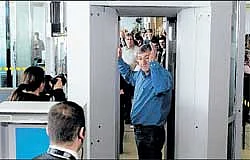
The body scanners emit radiation up to 20 times more powerful than previously thought and could be particularly risky for children, said Dr David Brenner, head of Columbia University’s centre for radiological research.
Although the “individual risks” associated with X-ray backscatter scanners are probably extremely small, it could multiply with the number of scanning, he said.
“If all 800 million people who use airports every year were screened with X-rays then the very small individual risk multiplied by the large number of screened people might imply a potential public health or societal risk. The population risk has the potential to be significant,” Dr Brenner was quoted as saying by the “Daily Mail”.
There should be more research on the device to look at the way it affects specific groups who could be more sensitive to radiation, he said.
According to him, children and passengers with gene mutations — around one in 20 of the population — are more at risk as they are less able to repair X-ray damage to their DNA.
The most likely risk from the airport scanners is a common type of skin cancer called basal cell carcinoma, he said.
Curable, not deadly
The cancer is usually curable and often occurs in the head and neck of people aged between 50 and 70. Dr Brenner pointed out that it would be difficult to hide a weapon on the head or neck so proposes missing out that part of the body from the scanning process.
“If there are increases in cancers as a result of irradiation of children, they would most likely appear some decades in the future. It would be prudent not to scan the head and neck,” he added.
Dr Brenner, who is originally from Liverpool but now works at the New York university, recently aired his concerns to the Congressional Biomedical Caucus in the US — members of Congress who meet to exchange ideas on medical research.
He urged them to look at his concerns but said it was important to balance any health issues against passengers’ safety when flying.
He said: “There really is no other technology around where we’re planning to X-ray such an enormous number of individuals. It’s really unprecedented in the radiation world.”
Meanwhile, UK’s Civil Aviation Authority insisted that the technology is safe and said their tests showed that it would take 5,000 trips through the scanner to equal the dose of a single chest X-ray.
“Under current regulations, up to 5,000 scans per person per year can be conducted safely,” a CAA spokesman said, adding that in the climate of high security, it is essential that security staff use “all means possible” to minimise risks to airline security.